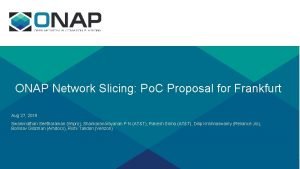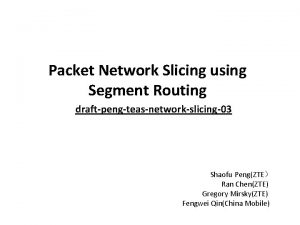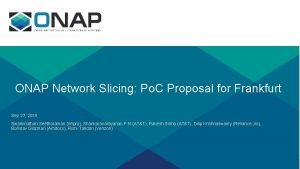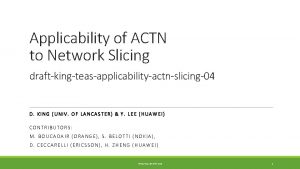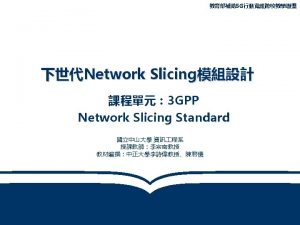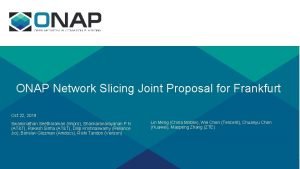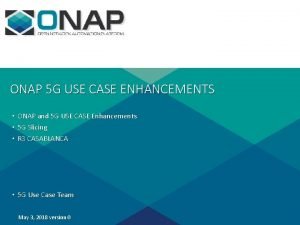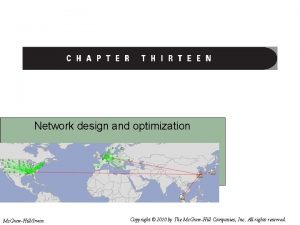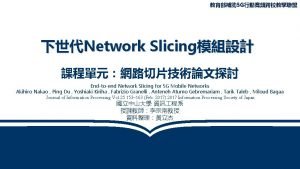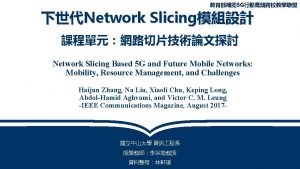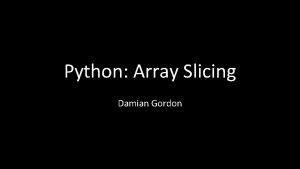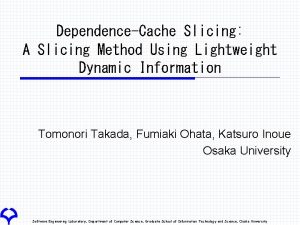5 G Network Deployment Slicing Network Optimization and










- Slides: 10

5 G Network Deployment, Slicing, Network Optimization and Automation Framework – Use Case Overview Key Gaps/Enhancements in ONAP R 2 to make ONAP carrier-grade 5 G Use Case Team

Contributors: Supporting Companies Contributing Members Alla Goldner Kaniz Mahdi Erik Westerberg Trung Nguyen Tim Strickland Oskar Malm Karpura Suryadevara Paul Bullock Peter Loborg Vimal Begwani Denis Fluet Vivien Yang Shekar Sundaramurthy Todd Morris Ranjit Cavatur Tom Tofigh Alex Dodin Rajesh Gadiyar Gil Bullard Rodney Wilson Eng Wei Koo Sarat Puthenpura Raghu Ranganathan Dmitriy Andrushko Cagatay Buyukkoc Stephen Terrill George Lapiotis Slawek Stawiarski John Quilty Vladimir Yanover

Business Drivers: • 5 G and network slicing are emerging technologies that are complex and distributed • Multiple service providers are getting ready to deploy • This will help 5 G technology vendors to understand ONAP requirements and deliver PNF / VNF capabilities that can be managed using ONAP • This use case is expected to: • Identify key ONAP platform capabilities/gaps for supporting the use case • Demonstrate use of ONAP platform to realize: • Deployment of the hybrid 5 G Network (VNF/PNF) • On-boarding 5 G node list (including PNF) into ONAP, configuration of the nodes to handle traffic, actively monitor and manage the nodes • Creation & Management of Slices within the deployed network • Using ONAP complex services to model, on-board, create, configure and manage the slices • Optimization of the deployed 5 G network and the slices • OOF enhancements for optimal placement of resources • Optimization of the %G network using low-latency data collection & analysis

A: 5 G Radio Access – Network Architecture ONAP Management - Design 5 G Application Ecosystem ONAP Management - Runtime Core Network Elements RAN Network Elements Macro Radio & Small Cell Antennas Disaggregated Core 5 G Base Stations CU-CP-H UPF CU-CP-L UE/CPE RU CU-UP DU Front Haul Mid Haul Back Haul SMF Centralized Cloud UDM AUSF Internet External Content Edge Cloud RU – Remote Radio Unit DU – Distributed Unit (5 G Base Unit) CU-UP – Centralized User Plane CU-CP – Centralized Control Plane (low and high) UPF – User Plane Function SMF – Session Management Function UDM – Unified Data Management Function AUSF – Authentication Service Function

A: 5 G Radio Access Network Deployment Requirements Description Rationale (why R 2? ) Impacted ONAP components Participating Companies Disaggregated 5 G RAN consists of hybrid network elements (PNF and VNF) and will require a cloud infrastructure deployment at the edge. This sub-case will expand/enhance ONAP capabilities to support different lifecycle management aspects of PNF & VNF (including enhancements in SDK / certification, PNF onboarding, and SO, DCAE, A&AI support for PNF). This requires addressing the missing platform capabilities: • Include Enhanced Platform Awareness (EPA) -- (e. g. access to real-time VIM features for CU-UP) https: //wiki. onap. org/display/DW/Beijing+Functional+Requirements+for+TSC+Approval • Enhance SDC (e. g. PNF onboarding) • Enhance SO (e. g. PNF, nested services ) • Enhance SDN-C and App-C to support RAN element configuration • Integrated design environment (e. g. complex service composition) • PNF Modelling Capability (e. g. PNF modeling, connections) • Edge Cloud Support (post R 2) Scaled carrier deployments will include some PNFs to meet specialized requirements - hence, support for PNF is a critical requirement for a carrier-grade ONAP (V/P)NF-SDK, SDC, SO, SDN-C, APP-C, AAI, DCAE, Portal AT&T Amdocs Ciena Ericsson Intel For details regarding the requirements, please see https: //wiki. onap. org/display/DW/Missing+Platform+capabilities

B: 5 G Network Slice – Network Architecture ONAP Management - Design ONAP Management - Runtime Mobile Slice Services (e. g. e. MBB, Massive Io. T, Mission-critical Io. T) E 2 E Slice Instances (NSIs) 5 G Application Ecosystem RAN Network Slice Segment (NSSIs) Transport Slice Segments (NSSIs) Core Slice Segments (NSSIs) RAN Abstraction Model Transport Abstraction Model Core Abstraction Model Macro Radio & Small Cell Antennas Disaggregated Core 5 G Base Stations CU-CP-H UPF CU-CP-L RU Front Haul UE/CPE Centralized Cloud CU-UP DU Mid Haul RU – Remote Radio Unit CU-UP – Centralized User Plane UPF – User Plane Function UDM – Unified Data Management Function Edge Cloud SMF Back Haul DU – Distributed Unit (5 G Base Unit) CU-CP – Centralized Control Plane (low and high) SMF – Session Management Function AUSF – Authentication Service Function UDM AUSF Internet External Content

B: 5 G Slice Management – ONAP Functional Requirements Description Rationale (why R 2? ) Impacted ONAP components Participating Companies Many providers are interested in using ONAP to manage the general concept of Slicing (Extending the cloud notion of sharing network/compute/storage to sharing network functions and Services implemented across PNFs & VNFs). Supporting such a generic slicing concept could require ONAP enhancements in the areas of SDC/AAI modeling and service definition, lifecycle management of slices (whether done within the existing SO/controller context or via a new layer of control e. g. slice controller) since slices could have their own state, metrics and scaling procedures different and distinct from those of the underlying network functions (e. g. service/slice across multiple NFs from different providers). This requires addressing the missing platform capabilities: § Enhance SDC to model & define slice segments (RAN, Transport, core), E 2 E slice, and Mobility services using one or more slices § Enhance SO Instantiate and lifecycle manage nested slice segments, E 2 E slicing and slicing services § Enhance A&AI to inventory and store state of slice segments, slice instances, and 5 G slicing services § Integrated design (e. g. complex service composition) § Support Service Aggregation (e. g. complex service hierarchy) § Support Service Chaining (e. g. across multiple clouds, service path) § Support Service Modification Capability (e. g. modifying without downtime) § Define and instantiate monitoring and management of complex nested slice segments, slice instances and slice services Typical carrier deployments will be complex enough to need support for nested / complex services, service aggregation, service path, correlation across multiple services - hence, these are critical functional requirements for a carrier-grade ONAP SDC, SO, SDN-C, APP-C, AAI, DCAE, Multi-cloud, Portal AT&T Amdocs China Mobile Ciena Cisco Ericsson Huawei For details regarding the requirements, please see https: //wiki. onap. org/display/DW/Missing+Platform+capabilities Intel

C: OOF & Network Optimization ONAP Functional Requirements: Description Rationale (why R 2? ) Impacted ONAP components Participating Companies Many providers are interested in flexibly deploying network optimization functions from various vendors into the ONAP framework. We need such an ONAP Optimization Framework (OOF) to support two aspects. The first one is for the optimal placement of 5 G virtual network functions. The second one is for performance optimization, where SON is a key functionality. Since optimization problems in general have a common structure (viz. maximizing/minimizing an objective subject to various constraints), a framework exploiting this commonality would render significant efficiency in creating optimization functions in these two areas. Also, when different optimization capabilities are deployed, there is a need for potential conflict resolution across these different schemes (both at design and run time). Hence the OOF should support policy-driven optimization capabilities that can be quickly developed and onboarded. To support OOF, the data collection/processing in DCAE need to satisfy the needed latency requirements based on various use cases. Note: The conflict resolution portion is deferred to a future release pending further definition & clarification of scope Typical carrier deployments are expected to be very distributed requiring low-latency data collection & policy-based analysis at the edges (potentially across different clouds) - hence need for OOF enhancements for optimal placement of resources and multi-cloud, Policy framework enhancements for conflict resolution, DCAE scalability enhancements for high-volume & lowlatency collection & analysis are critical to make ONAP carrier grade SDC (including Policy Design), SO, SDN-C, APP-C, AAI, DCAE, Multi-cloud, OOF, Portal AT&T Cisco Intel VMWare For details regarding the requirements, please see https: //wiki. onap. org/display/DW/Missing+Platform+capabilities

Summary of ONAP Platform Impacts Functional Platform Requirements SDC AAI SO SDN-C APP-C Portal DCAE Policy OOF Support for PNF - Onboarding Support for PNF - Configuration & Control Support for PNF - Data Collection & Monitoring Slice Management - Definition Slice Management - Composition Slice Management - Orchestration & Control Slice Management - Data Collection & Monitoring Optimization - Onboarding Optimization - Configuration & Control Optimization - Data Collection & Monitoring Optimization - Conflict Resolution OOF - Multi-cloud OOF - Optimization New / Enhancement Impacted 9

s Thank You!
